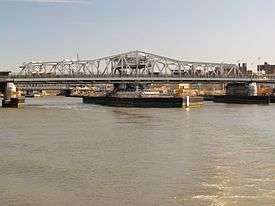Third Avenue Bridge (New York City)
| Third Avenue Bridge | |
|---|---|
|
| |
| Coordinates | 40°48′27″N 73°55′57″W / 40.8076°N 73.9325°WCoordinates: 40°48′27″N 73°55′57″W / 40.8076°N 73.9325°W |
| Carries | Five lanes of Third Avenue |
| Crosses | Harlem River |
| Locale |
Manhattan and the Bronx, New York City |
| Other name(s) | 3rd Avenue Bridge |
| Owner | City of New York |
| Maintained by | NYCDOT[1] |
| Preceded by | Madison Avenue Bridge |
| Followed by | Willis Avenue Bridge |
| Characteristics | |
| Design | Swing bridge |
| Total length | 2,800 feet (853.44 m)[1] |
| Longest span | 300 feet (91.44 m)[1] |
| History | |
| Construction cost | $119 million[1] |
| Opened | August 1, 1898[1] |
| Rebuilt | December 6, 2004 |
| Statistics | |
| Daily traffic | 55,096 (2016)[2] |

The Third Avenue Bridge carries southbound road traffic on Third Avenue over the Harlem River, connecting the boroughs of Manhattan and the Bronx in New York City. It once carried southbound New York State Route 1A. The Third Avenue Bridge carries traffic south from the intersections of either Third Avenue and East 135th Street, or Bruckner Boulevard and Lincoln Avenue, in the Bronx. On the Manhattan side, the bridge funnels traffic into three locations: East 128th Street; the intersection of East 129th Street and Lexington Avenue; or the southbound Harlem River Drive in Manhattan.
The bridge was formerly bidirectional, but converted to one-way operation southbound on August 5, 1941 on the same day the Willis Avenue Bridge was similarly converted to one-way northbound.[3] In 1955, the original multi-truss bridge constructed in 1898, was removed and sold as two bridges to another municipality (to date, no records of that municipality or the whereabouts of the 1898 bridge have been discovered).
Reconstruction
As part of a major NYCDOT reconstruction project from 2001-2005, a new swing span was floated into place on October 29, 2004 and two lanes of Manhattan-bound traffic opened on December 6, 2004, with the remaining five lanes opened in 2005. In addition of replacing the swing span and its machinery, the Project included redesigned approach ramps to the bridge on the Bronx side and off the bridge in Manhattan. As reconstructed, the Third Avenue Bridge carries five lanes of Manhattan-bound traffic from the Bronx, which split to three ramps in Manhattan: to East 128th Street and Second Avenue; to Lexington Avenue and East 129th Street; and to the southbound Harlem River Drive/FDR Drive.
For 2011, the New York City Department of Transportation, which operates and maintains the bridge, reported an average daily traffic volume of 59,603; the bridge reached a peak ADT of 73,121 in 2000.[4]
Public transportation
The Third Avenue Bridge carries the Bx15 bus route operated by MTA New York City Transit. The route's average weekday ridership is 19,951.[5]
TV Documentary
Discovery Channel contracted Barner-Alper Productions of Toronto to produce an episode of Mega-Builders, titled "Spanning the Harlem", about the work leading up to the float-in of the swing span.[6] It first aired in late 2004, only in Canada on Discovery Canada, but was later released circa 2007, on Discovery Channel in the US (and throughout the world).
References
- 1 2 3 4 5 Michael R. Bloomberg, City of New York (January 23, 2004). "New York City's Harlem River Bridges: The Reauthorization of the Transportation Equity Act for the 21st Century" (PDF). Retrieved December 2, 2017.
- ↑ "New York City Bridge Traffic Volumes" (PDF). New York City Department of Transportation. 2016. p. 9. Retrieved March 16, 2018.
- ↑ "One-way Bridges to Ease Traffic". The New York Times. August 5, 1941. Retrieved August 28, 2012.
- ↑ "New York City Bridge Traffic Volumes 2008" (PDF). New York City Department of Transportation. March 2010. p. 74. Retrieved June 27, 2010.
- ↑ "Average Weekday NYC Transit Bus Ridership". MTA New York City Transit. 2012. Retrieved July 4, 2012.
- ↑ Episode on Discovery Channel